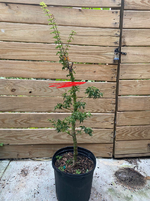My initial reaction was exactly what
@0soyoung expressed, and I still lean this way.
I perform a lot of shishigashira air layers every year, which means I am constantly pruning big branches like you've done, and I often see the mechanics of what you're seeing, but I believe there are 2 factors making your situation particular and problematic:
The stub you left
should have have given your tree enough time to compartmentalize the dieback and save the trunk, if the remainder of the tree--and especially the branches above the cut-site--were relatively vigorous. However, it looks like the branch that you cut and removed in the apex was very thick in contrast with its closest neighbouring branches and those remaining above it. It is possible that the young shoots above the cut-site simply didn't have the pull to contain the die back. The other factor that is particular about your situation is that it looks like the branch collar makes up about 80-90% of the trunk at that junction (see 1st image attached), and so while we normally expect dieback up to and into the branch collar, in this case that area makes up a significant majority of your trunk. This would have been less of an issue if the branches above the cut-site were much stronger (of course timing etc. are also important).
I would not be overly concerned in your situation. When I remove air layers from my shishigashiras I often see what you are seeing, although in general I try to avoid situations with compounding problematic factors like the situation you're facing now. That said, I prefer to see die back that looks like the big cut-site above the one we're discussing (see 2nd attached image), and especially at this time of year I would be concerned that a pathogen will or already has entered the tree at this weak location. I would personally cut where you indicated in your last post, with sterile tools, clean hands, and I would seal the wound.






















